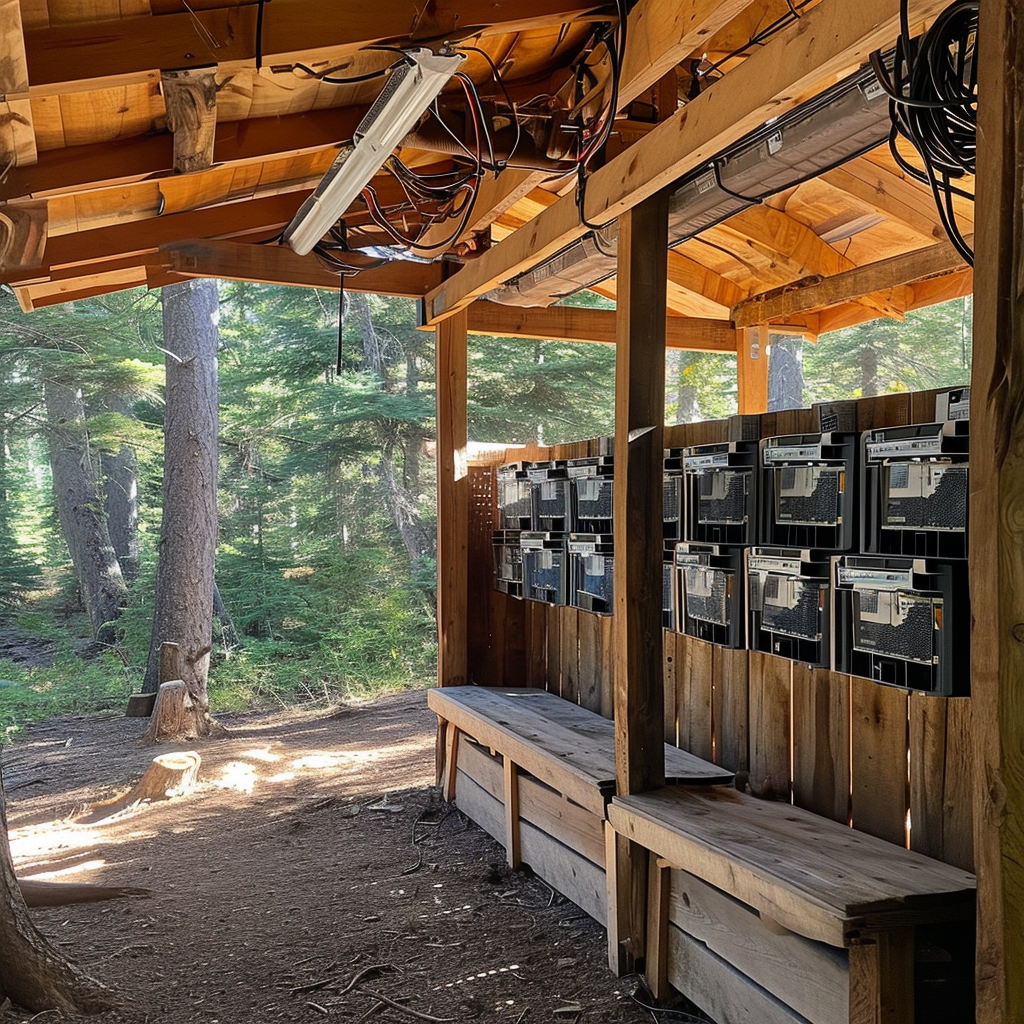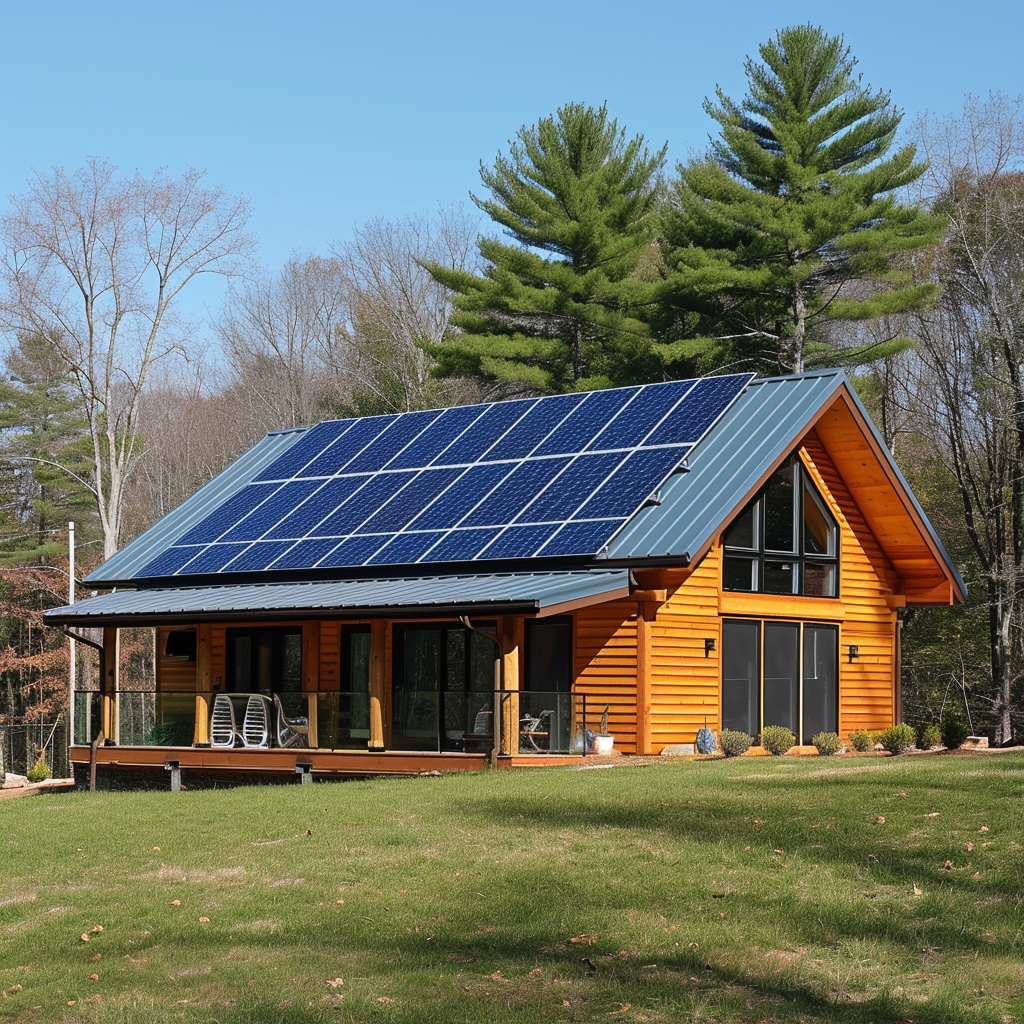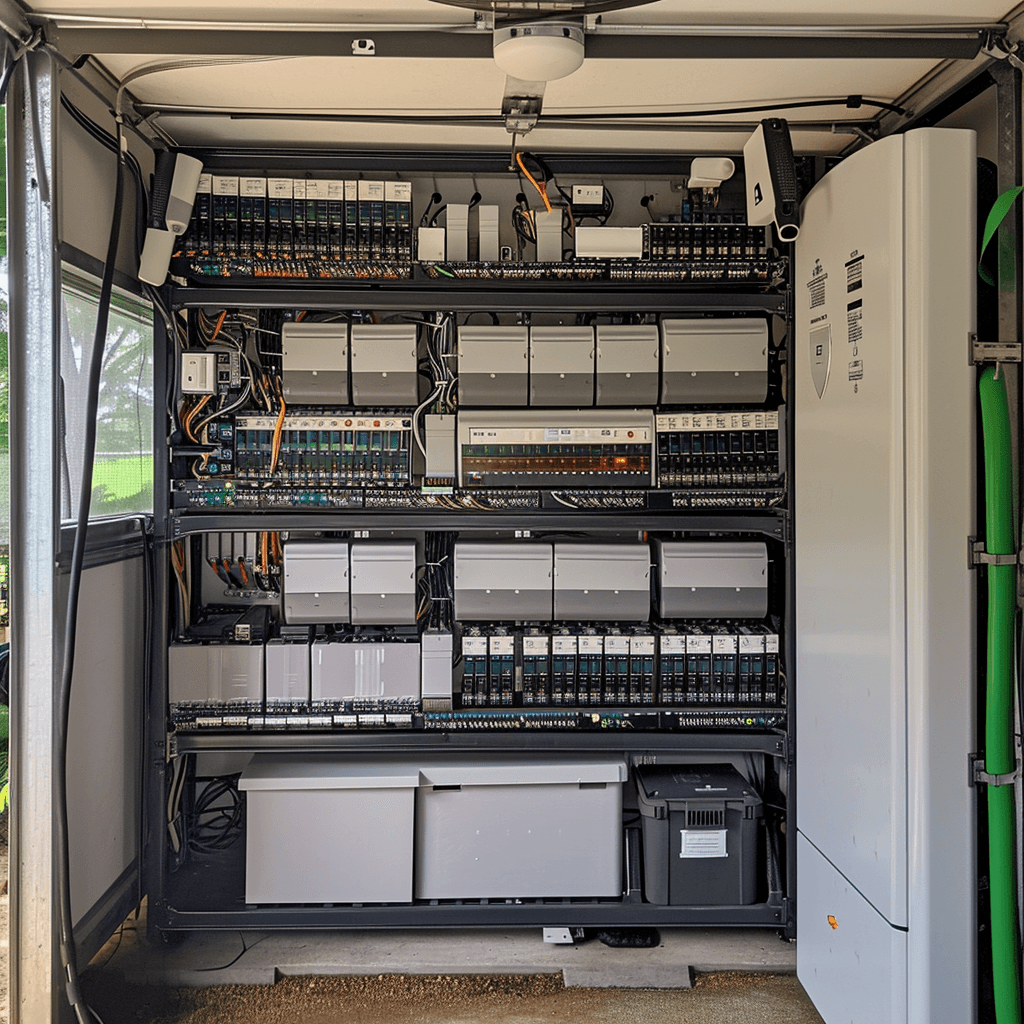Have you ever thought about living off the grid? It’s an adventurous lifestyle that allows you to disconnect from the hustle and bustle of city life and rely on renewable energy sources. One of the essential components of off-grid living is a battery bank. So you might also have thought about it, how big of a battery bank do I need to be off-grid? These banks store the excess energy produced by your solar panels or wind turbines for later use. But how do you choose the right battery bank for your off-grid lifestyle? Well, in this article, we’ll explore all the factors you need to consider to make an informed decision.
When it comes to choosing the right battery bank for off-grid living, the size of the bank is crucial. The size depends on your energy needs and how long you plan to be off-grid. Start by estimating your daily energy consumption and then calculate the total energy required to power your appliances for the desired number of days between battery recharges. This estimation will give you a rough idea of the battery bank capacity you need. However, it’s always recommended to opt for a slightly larger capacity to account for unexpected energy demands or days with limited sunlight.
Apart from the size, you’ll need to consider the battery type. Off-grid battery banks commonly use deep cycle batteries, which are designed to provide a steady and reliable output over an extended period. The most popular types of deep cycle batteries are flooded lead-acid batteries, gel batteries, and AGM batteries. Each type has its advantages and disadvantages in terms of lifespan, maintenance requirements, and cost. We’ll dive deeper into these battery types in our upcoming article, so stay tuned to learn more about them.
Additionally, it’s essential to evaluate the battery bank’s voltage and wiring configuration. The voltage of your battery bank should match the voltage requirements of your off-grid system. It’s crucial to ensure compatibility between your solar panels or wind turbines and the battery bank to optimize energy usage and prevent damage to the system. Moreover, properly wiring your battery bank is essential for safety and efficiency. You’ll need to consider factors such as cable size, fusing, and the use of charge controllers to regulate the energy flow.
So, whether you’re planning to embark on an off-grid adventure or contemplating the idea, choosing the right battery bank is of utmost importance. In our upcoming articles, we’ll delve deeper into each aspect discussed here and provide you with valuable insights to help you make the best decision. Stay tuned to learn more about the different battery types, their pros and cons, and the optimal wiring configurations for your off-grid lifestyle.
Choosing the Right Battery Bank for Off-Grid Living
Living off-grid is an increasingly popular choice for those seeking independence, self-sustainability, and a more environmentally friendly lifestyle. The ability to generate and store your own energy is a key component of off-grid living, and a reliable battery bank is essential for this purpose. In this article, we will explore the factors to consider when choosing a battery bank for off-grid living and provide insights into the different types of batteries available.
Saving on Energy Costs
One of the primary benefits of living off-grid is saving on energy costs. By generating your own power through renewable energy sources such as solar panels or wind turbines, you can significantly reduce or eliminate your reliance on the grid. However, to fully maximize the cost-saving potential, it is essential to have an efficient and reliable battery bank to store excess energy for use during periods of low generation or high demand.
Reduced Dependence on the Grid
Living off-grid means reducing your dependence on the traditional energy grid. This independence provides a sense of security, knowing that you are not at the mercy of power outages or fluctuations in energy prices. With a well-designed battery bank, you can store sufficient energy to sustain your household’s needs, ensuring a constant and uninterrupted power supply.
Environmental Sustainability
One of the core principles of off-grid living is environmental sustainability. By generating your own clean and renewable energy, you contribute to reducing carbon emissions and minimizing your ecological footprint. A battery bank plays a critical role in this sustainability by storing excess energy for use when renewable energy generation is not available, such as during the night or on overcast days.

Understanding Battery Banks for Off-Grid Living
To fully harness the benefits of off-grid living, it is important to understand the significance of battery banks. These banks are essentially energy storage systems that store excess energy generated from renewable sources, allowing you to power your home even when there is no direct generation.
Importance of Battery Banks
The importance of a battery bank cannot be overstated when living off-grid. It acts as a buffer between energy generation and consumption, ensuring a steady and reliable power supply. Without a battery bank, surplus energy generated during peak production periods would go to waste, limiting your ability to be self-sufficient and independent.
Components of a Battery Bank
A battery bank is composed of multiple batteries connected in series or parallel to increase the overall capacity and voltage. The capacity of a battery bank is measured in ampere-hours (Ah), while the voltage is typically 12, 24, or 48 volts, depending on the system design. In addition to batteries, a battery bank also requires a charge controller, an inverter, and protective components like fuses and breakers.
Factors to Consider When Choosing a Battery Bank
Selecting the right battery bank for off-grid living involves considering several important factors to ensure optimal performance and longevity. Here are a few key factors to consider:
Power Requirements
Before choosing a battery bank, it is essential to determine your power requirements. This involves evaluating the energy consumption of your appliances and devices. Make a list of the wattage ratings and estimated daily usage for each item. By adding up the daily energy consumption, you can estimate the capacity required for your battery bank.
Battery Capacity
Battery capacity refers to the amount of energy a battery can store. It is typically measured in kilowatt-hours (kWh). To determine your battery bank capacity, consider your daily energy consumption and the number of days without renewable energy generation that you want your battery bank to sustain. A larger battery capacity ensures a longer backup duration but also increases the initial cost and space requirements.
Battery Chemistry
Different battery chemistries offer varying characteristics in terms of capacity, lifespan, efficiency, and maintenance requirements. The commonly used battery chemistries for off-grid living are lead-acid, lithium-ion, saltwater, and flow batteries.
Maintenance and Lifespan
It is important to consider the maintenance requirements and lifespan of the battery bank. Some batteries may require regular watering, equalizing charges, or specific temperature conditions for optimal performance and longevity. Understanding and following the manufacturer’s recommendations for maintenance will help maximize the lifespan of your battery bank.
Types of Battery Banks
Now let’s explore the different types of battery banks commonly used for off-grid living:
Lead-Acid Batteries
Lead-acid batteries have been used for decades and offer a relatively low upfront cost. They are available in two main types: flooded lead-acid (FLA) and sealed lead-acid (SLA) batteries. FLA batteries require regular maintenance, including checking electrolyte levels and replenishing distilled water. SLA batteries are maintenance-free but have a higher cost.
Lead-acid batteries have a moderate lifespan and can provide reliable power for off-grid living. However, they require proper ventilation and should not be discharged below 50% capacity to maximize their lifespan.
Lithium-Ion Batteries
Lithium-ion batteries have gained popularity in recent years due to their high energy density, longer lifespan, and better efficiency. They require minimal maintenance and have a higher upfront cost compared to lead-acid batteries. Lithium-ion batteries can be discharged to a lower capacity without adversely affecting their lifespan, which means they can provide more usable energy.
Saltwater Batteries
Saltwater batteries, also known as saltwater or seawater batteries, use a non-toxic and eco-friendly electrolyte solution. They offer a longer lifespan than lead-acid batteries and require minimal maintenance. Saltwater batteries can be discharged to a greater extent without compromising their lifespan, providing a higher usable capacity. However, they have a higher upfront cost.
Flow Batteries
Flow batteries store energy in external tanks and separate the energy storage capacity from the power rating. They offer a longer lifespan and unlimited capacity expansion compared to other battery types. Flow batteries are also highly modular, allowing for easy replacement of individual components. However, they have a higher upfront cost and require more space.
Calculating the Required Battery Capacity
To determine the required battery capacity for your off-grid living needs, you need to consider your energy consumption and the number of days your battery bank should sustain you without renewable energy generation.
Determining Energy Consumption
Make a list of all your appliances and devices that will be powered by the battery bank. Determine their power consumption in watts and estimate the average daily usage in hours. Multiply the power consumption by the hours of usage and sum up these values to get the total daily energy consumption in watt-hours (Wh).
Sizing the Battery Bank
To size your battery bank, multiply the total daily energy consumption by the desired number of days the battery bank should sustain you without renewable energy generation. Ensure to account for any inefficiencies introduced by the battery bank, such as charging or discharging losses. Dividing this value by the battery voltage will give you the required battery capacity in ampere-hours (Ah).
Determining Power Requirements
Assessing the power requirements of your appliances and devices is crucial in determining the size and capacity of your battery bank.
Assessing Appliances and Devices
Look at the power ratings of your appliances and devices, usually found on the nameplates or user manuals. Convert any ratings given in watts (W) to kilowatts (kW) by dividing by 1,000. Make a list of all these power ratings.
Calculating Daily Energy Consumption
Estimate the average daily usage in hours for each appliance or device. Multiply the power rating in kilowatts (kW) by the average daily usage in hours to calculate the daily energy consumption in kilowatt-hours (kWh). Sum up these values for all appliances and devices to get your total daily energy consumption.
Choosing the Right Battery Chemistry
Each battery chemistry offers its own pros and cons in terms of performance, lifespan, efficiency, and cost.
Pros and Cons of Lead-Acid Batteries
Lead-acid batteries have a relatively low upfront cost and are widely available. They are well-tested and reliable, with a moderate lifespan. However, they require regular maintenance, specific ventilation, and should not be discharged below 50% to maximize their lifespan.
Advantages and Disadvantages of Lithium-Ion Batteries
Lithium-ion batteries have a higher upfront cost but offer higher energy density, longer lifespan, and better efficiency compared to lead-acid batteries. They require minimal maintenance and can be discharged to a lower capacity without compromising their lifespan.
Benefits of Saltwater and Flow Batteries
Saltwater batteries have a longer lifespan than lead-acid batteries and require minimal maintenance. They can be discharged to a greater extent without adversely affecting their lifespan, providing a higher usable capacity. Flow batteries offer a longer lifespan and unlimited capacity expansion, with easy component replacement. However, both saltwater and flow batteries have a higher upfront cost.
Maintaining and Maximizing Battery Lifespan
Proper maintenance and care are essential to maximize the lifespan of your battery bank and ensure optimal performance.
Regular Inspection and Cleaning
Regularly inspect your battery bank for any signs of damage, leakage, or corrosion. Clean the terminals and connectors using a suitable cleaning agent to prevent any buildup or poor connection.
Temperature Control
Ensure that your battery bank is kept within the recommended temperature range by providing suitable ventilation or utilizing insulation. Extreme temperatures can negatively affect battery performance and lifespan.
Proper Charging and Discharging
Follow the manufacturer’s recommendations for charging and discharging your battery bank. Avoid overcharging or deep discharging, as these can significantly impact the lifespan and capacity of the batteries.
Avoiding Overcharging and Deep Discharging
Overcharging and deep discharging can lead to irreversible damage to your batteries. Utilize smart charge controllers and battery management systems to prevent these issues and ensure optimal battery performance.

Safety Considerations
When installing and utilizing a battery bank for off-grid living, it is important to prioritize safety to prevent any accidents or hazards.
Battery Enclosures
Use appropriate battery enclosures or cabinets to safely house your battery bank and protect it from external elements or physical damage. Ensure that these enclosures meet the recommended safety standards.
Ventilation
Proper ventilation is crucial to prevent the buildup of flammable gases, especially with lead-acid batteries. Install ventilation systems or vents to provide sufficient airflow and reduce the risk of combustion.
Fire Prevention
Implement proper fire prevention measures, such as installing smoke detectors, fire extinguishers, and utilizing flame-retardant materials. Regularly inspect your battery bank and surrounding area for any potential fire hazards.
Conclusion
Choosing the right battery bank is an integral part of off-grid living. By considering factors such as power requirements, battery capacity, chemistry, maintenance, and lifespan, you can make an informed decision that aligns with your needs and preferences. Whether you opt for lead-acid batteries, lithium-ion batteries, saltwater batteries, or flow batteries, the key is to select a battery bank that provides reliability, efficiency, and longevity. With a well-designed and dependable battery bank, you can enjoy the freedom and sustainability of off-grid living.




